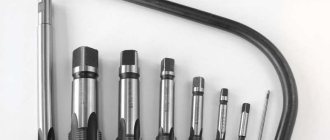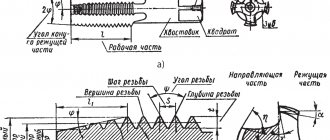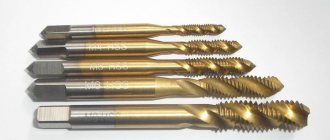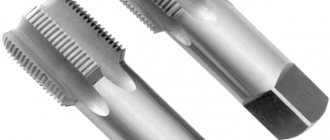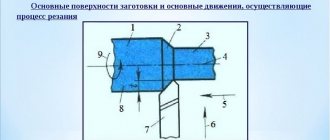A threaded connection is one of the most popular ways of fastening various parts and elements. It is not always possible to purchase various fasteners that already have threads applied, so you need to cut them yourself. For this purpose, specialized thread cutting tools are used. With their help, it is also possible to renew previously worn or otherwise damaged threads.
Types of Threading Tools
There are 3 types of tools used for thread cutting:
- Tap.
- Die.
- Klupp.
The cutting tool differs not only in diameter, but also in the type of thread created. It can be metric or inch. Metric is used on the vast majority of fasteners. It is used in mechanical engineering, household equipment and other areas. Inch threads are used exclusively on plumbing elements. In some countries, metric threads are not used at all, and all fasteners are made using inch threads.
Another important difference between such a tool is the direction of the thread being created. It can be left or right. You cannot use one tool to cut threads in both directions if it is not universal.
Tap
A tap is a cylindrical tool that is designed for cutting internal threads in pipes and nuts. Its surface has protruding ribs, which, when screwed into hollow metal elements of suitable diameter, create helical grooves, cutting out chips. As a result of screwing in, the tap creates a thread. This device is a small metal rod made of high-quality hard steel, at one end of which there is a cutting part, and at the other a shank for connecting a wrench. There is a recess along the surface of the tap, through which the removal of cut chips is ensured. The most convenient for use are tools that have 3-5 grooves for chip removal. They clog much less and provide a clean surface without visible deformation. After cutting the thread using a tap, the bolt or stud is screwed effortlessly over the entire surface.
Using a tap, you can cut a thread or calibrate it if it is damaged.
This tool comes in three varieties:
- Manual.
- Machine.
- Nut.
Hand taps are usually offered in a set of 2-3 tools of the same diameter. The former provides rough thread cutting, while the latter creates a high-quality, smooth profile that allows bolts or studs to turn easily. The order of use of the taps that come in the set is indicated by numbers on their body.
Machine tools are designed for cutting threads on machines. They have a different groove profile for faster chip removal. In this case, the shape of the shank is adjusted to fit into the chuck on the machine.
Nuts are used specifically for nuts. They are easy to recognize because they are the shortest. Since this tool is designed for cutting threads only in nuts, which are usually small in width, it is made very short. In this regard, its length allows you to make a maximum of 12 turns. Nut taps can also be roughed or finished. The roughing only creates the initial thread for screwing in the intake part of a longer tool.
To properly secure a hand- or nut-type tap, a special wrench is used, which is mounted on the shank. The rake angle of a tap determines its application and the metal it can work with. The angle with an inclination of 5 to 10 degrees makes the tool convenient for processing steel. A slope of 0 to 5 degrees is intended for cast iron. Taps with sharpening from 10 to 25 degrees are used for non-ferrous metals and their alloys.
Die
The die (die) is used to create screw threads on bolts and studs. It is a round washer with a central hole, which has several protruding ribs with a sharp edge. The die cuts and calibrates external threads in one pass. It is usually used for cutting threads on rods with a diameter of up to 52 mm. The standard thickness of the dies is from 8 to 10 turns. The angle of the cut protrusions on the die may vary. A tool with an angle of 40-60 degrees is used for through passage. In the event that it is necessary to cut the thread close to the stop, a die with an angle of 90 degrees is used.
General information about threading
When choosing a tool for cutting threads, you should take into account the characteristics of the threaded surfaces. These include the following points:
- The cutting of turns is carried out mechanically using special equipment. When metal is removed, grooves and coils are formed that fit perfectly with the surface of the second element.
- All thread cutting tools and technologies used can be divided into two categories: manual and automated. For a long period, screw-cutting lathes were used.
- When using hand tools for thread cutting, lubricant must be used. It significantly extends the service life of devices and simplifies the threading process itself.
Thread cutting with different types of dies
It is worth considering that manual versions have an internal surface, which determines the size of the turns and their location. In the case of processing on a screw-cutting lathe, the parameters of the future threaded surface are determined by the feed and speed of movement of the caliper.
The following versions are the most widely used:
- Similar tools are used to make bolts and studs. Such a product is a round washer, inside of which several ribs protrude. External threads can be formed and calibrated in just one pass. There are various versions of tools on sale; hardened tool steel is used in manufacturing.
- Taps are used to produce internal threads. It is also manufactured using hardened tool steel, which is characterized by high wear resistance. The tap has the shape of a rod, the working part of which has several depressions and protruding edges. Due to this, the thread cutting process is significantly simplified.
- Special heads can also be used to carry out the work in question. They can have different sizes and are used in conjunction with a special holder.
The cost of hand tools is low, but they are characterized by high efficiency in use.
How to properly cut turns on a water pipe
Recommendations for cutting turns on a water pipe are largely related to what technology is used. Hand tools for cutting external threads should be used taking into account the following information:
- It is necessary to use lubricants that are added to the cutting zone to reduce the wear of the cutting edge.
- At the time of work, you need to ensure that the tool is positioned strictly perpendicular to the workpiece. If it is displaced, the turns may be positioned incorrectly relative to each other.
- When thread cutting, attention is paid to ensuring that chips are removed from the cutting zone in a timely manner.
Tapping a water pipe
The work in question can also be carried out in domestic conditions.
Tap design
A tap is a kind of hardened screw that has protruding ribs with several cut helical or straight grooves - cutting edges. When screwed into hollow workpieces of the appropriate diameter, such corrugated ribs cut out chips, removing them from the machined area of the hole and leaving similar helical grooves on the walls of the part - threads.
A simple thread-cutting device, a tap, is essentially an iron rod made of high-quality solid steel, with a cutting part on one edge and a shank with a square element on the other (for manual models) for attaching a crank, which serves for reciprocating movements of the tap in process of work.
The working area of the tool for cutting internal screw threads is conventionally divided into parts:
- cutting part (intake), which ensures the main cutting of the processing allowance;
- a calibrating section that finalizes the thread;
- feathers (ribs with screw threads);
- grooves for removing chips (small taps have 3 grooves; large ones, with a diameter greater than 20 mm, have 4 grooves);
- core, which gives the tap rigidity and strength.
Die work
Dies are used to process the outer cylindrical surface. Among the features of its application, the following points can be noted:
- The workpiece is secured in a vice. It must remain stationary during operation.
- Before using the tool, the cutting edge and the surface being processed are lubricated with oil.
- As a rule, a small chamfer is created on the end surface. It simplifies the process of screwing the die onto the surface to be treated.
- During work, you need to pay attention to ensure that the die does not move. Because of this, the thread may be cut unevenly and the die stroke becomes more difficult.
- For 2-3 turns along the thread, one turn is made in the opposite direction. This ensures the removal of chips from the processing zone and improves the quality of the resulting surface.
Clupp work
To carry out the work in question, a clamp can be used. It resembles a die, but is large in size. It is often used for cutting threads on pipes and is supplied in special sets with handles. Among the application features we note:
- The clamp is characterized by high efficiency, so the process of cutting turns is simplified.
- The instructions for using the die and die are almost identical, the only difference is how much force needs to be applied to obtain the required result.
A thread cutting kit is often represented by a combination of nozzles of various diameters. In the manufacture of the working part, wear-resistant material is also used, which does not dull during prolonged use.
If you find an error, please select a piece of text and press Ctrl+Enter.
Due to their high reliability and simplicity, threaded connections are widely used in various building structures, machines and mechanisms. Since the basic geometric parameters of threads are generally accepted, it is enough to have a small set of standard tools to create new connections and repair worn units.
Internal thread
The internal thread is cut into the hole using taps (1). They are metal rods with hardened teeth. Manufactured from tool or high-speed steel.
Types of taps
Taps are distinguished by purpose. They can be used for cutting metric, inch, tapered, pipe, and trapezoidal threads. According to the relevant technical specifications, as well as GOST 3266-81, the table shows the limits of applicability of this tool.
| Thread name | Nominal diameters |
| Metric | 1 - 52 mm |
| Inch | 1/4” - 2” (inches) |
| Conical | 1/16” — 2” |
| Pipe | 1/16” — 6” |
| Trapezoidal | 5.6 - 90 mm |
Taps for cutting metric and inch threads are manufactured in sets. The set can consist of either two, finishing and roughing, or three - roughing, medium and finishing taps. The roughing tap is designed to remove the bulk of the chips. Finishing is used for the final, precise shaping of the thread profile and calibration.
To identify the tap in the kit, its tail part is marked with one, two or three ring marks. It is also possible to designate using a number: I – rough, II – medium, III – finishing.
Nut taps are designed to cut threads in one pass. They are single-set, that is, sold individually.
To rotate the taps, use knobs (2). They can be non-adjustable with square holes for a fixed size shank, or adjustable. In addition, there are wrenches with a ratchet mechanism, providing ease of work in hard-to-reach places.
Thread cutting tool
An axial multi-edged tool for forming and processing internal threads is called a tap, and external threads are called a die.
Hand taps are used for cutting internal threads.
The working part of the tap with length f is divided into cutting (taking) and guiding (calibrating) parts with lengths l1 and l2, respectively (Fig. 1, a). The cutters of the cutting part have main edges located on the conical surface and auxiliary edges that are part of the threaded profile (Fig. 1, b). The guide part serves to guide the tap and self-feed by screwing in, and also serves as a reserve for regrinding. The cone angle of the cutting part depends on the angle φ, which is set equal to 5° for hand taps, 3°30′ for nut taps and 6°30′ for machine taps. The guide part has a reverse taper to reduce friction and eliminate dangerous jamming of the tap in the hole.
Rice. 1. Structural elements (a), thread profile (b) and geometric parameters (c) of the tap
The length of the tap portion of the tap is taken to be 45 S for a rough tap, 2.55 S for a medium tap, and (1.5–2.0) S for a finishing tap, where S is the pitch of the thread being cut. Machine taps are made with a short taper equal to (1.5–2) S.
The rake angles of the taps are selected depending on the material being processed according to the following data:
- for soft steel γ = 12–15°;
- steel of medium hardness γ = 8–10°;
- hard steel γ = 5°;
- cast iron and bronze γ = 0–5°;
- light alloys γ = 25–30° (Fig. 1, c).
The tail part of the tap is designed to secure it in a driver or chuck and to transmit torque.
Hand taps are produced in sets. The kit includes three taps, which are divided according to their purpose into rough, medium and finishing. Chernovoy cuts the thread, removing up to 60% of the metal; the middle one gives more accurate threads, removing up to 30% of the metal; the third (finishing) tap performs final cutting and calibration of the thread, removing up to 10% of the metal.
For cutting pipe and small metric threads, use a set of two taps.
The taps included in the set differ from each other in thread profile and length of the intake part.
According to the design of the cutting part, two types of taps are distinguished - cylindrical and conical (Fig. 2; a, b).
Rice. 2. Formation of a cutting surface in a set of taps: a - cylindrical design, b - conical design
With a cylindrical tap design, all three tools in the set have different diameters. The finishing tap has a full thread profile. The diameter of the average tap is less than normal by 0.6 of the cutting depth, and the diameter of the rough tap is less than the thread diameter by the full cutting depth.
The length of the intake part, taking into account the distribution of thread cutting work between the three taps of the set, is set in the ratio 4:2:1. Thus, for a rough tap the length of the intake part is 6–7 threads, for a medium tap it is 3–3.5, and for a finishing tap it is 1.5–2 threads.
The cylindrical design of the tap ensures that the tips of the teeth cut chips in the form of wide platforms.
With a tapered tap design, all three tools in the set have the same diameter and full thread profile with varying tap lengths.
The thread within the intake part is made conical and additionally cut along the tops of the teeth into a cone.
For conical taps, the cutting part is equal: for a rough tap - the entire length of the working part, for a medium tap - half of this length, for a finishing tap - two threads.
Tapered taps are usually used when cutting through holes. Blind holes are cut with cylindrical taps.
The rear (back) surface (Fig. 1, c) of the cutting teeth is backed up in a spiral, which allows maintaining a constant profile of the teeth after they have been sharpened.
Collars and clamps . Threading with hand taps is carried out using cranks that fit onto the square ends of the shanks.
The most common are simple double-sided knobs (Fig. 3).
Rice. 3. Double-sided driver: a, a1, a2 - holes for tap shanks
Universal gates (Fig. 4) are a frame 1 with two crackers - movable 3 and fixed 4, forming a square hole. One of the handles 2 ends with a screw for clamping the square of the tap.
Rice. 4. Universal driver: a - hole for the tap shank
Another version of the universal driver is shown in Fig. 5. This driver allows you to work with taps whose square sizes range from 5x5 to 25x25 mm.
Rice. 5. Universal wrench
Round dies are used for cutting fastening threads on bolts, screws and studs when working manually and on machines (revolving, automatic, etc.).
The round die on each tooth 2 (Fig. 6, a) has a rear 1 and front 5 surface, a back of the tooth 3 and a cutting edge 6 formed by a chip hole 4. The round die has a cutting and guide part with lengths l1 and l2, respectively (Fig. 6 , b). The length of the cutting part is equal to one and a half threads of thread, and the thickness of the die is seven to eight threads.
Rice. 6. Structural elements (a), main parts (b) and shapes of chip holes (c) of a round die
Rake angles are taken for hard materials being processed γ = 10–12°; for materials of medium hardness γ = 15–20°; for soft materials γ = 22–50°.
Dies are used (Fig. 7) solid (a), split (b) and sliding.
Rice. 7. Dies
When cutting manually, round and sliding dies are installed in special cranks and clamps.
The collars for round dies are made of a frame into the hole of which the die is placed (Fig. 8).
Rice. 8. Driver for a round die
The die is kept from turning by three locking screws (1, 2 and 3), the conical ends of which fit into recesses on the side surface of the die. The fourth screw fits into the slot of the adjustable die and secures the correct thread size.
The clamps for sliding dies (Fig. 9, a) are an oblique frame with two handles. In the central hole of the frame with dimensions A and C, sliding dies are installed and centered. Installation of the sliding dies to the required size is carried out using a pressure screw 1 acting on the movable part of the sliding dies.
Clusters for cutting threads on pipes differ from conventional ones in that four steel combs 2 fit into the slots of the clamp holder (Fig. 9, b).
Rice. 9. Dies: a - for sliding dies; b - for cutting threads on pipes
By turning the upper handle 1, you can bring the dies closer together or move apart, and thanks to this, use the same die for cutting threads on pipes of different diameters. The pipe die is equipped with guides 3, which are adjusted in the same way as the dies, by a lower handle 4. This ensures the correct position of the die on the pipe when cutting threads.
External thread
The external thread is manually cut into dies (5) and plugs (4). The die is a round nut made of high-speed or high-hardness tool steel. In order to remove chips, special holes are provided in it. The dies are either solid or split.
Split dies have a slot up to 1.5 mm in size. Thanks to this, they allow you to adjust the diameter of the cut thread within 0.1-0.3 mm. Their disadvantage is less accuracy, so using such a tool in critical connections is not recommended. The diameters of the dies are presented in the table.
| Thread name | Nominal diameters |
| Metric | 1 - 76 mm |
| Inch | 1/4” - 2” (inches) |
| Pipe | 1/8” — 2” |
The rotation of the dies is carried out using die holders (3) and ratchets. These devices typically allow multiple cutting tool sizes, such as M16 - M20, 1/2" - 1". Ratchets are used for cutting pipe threads with dies in hard-to-reach places, for example, near a wall.
The dies are designed for cutting external pipe threads with a diameter of 1/2" - 3". Thanks to their design, they are securely fixed to the pipe, which ensures ease of operation, as well as high quality threaded connections. Clupps are usually equipped with replaceable cutters or heads. This significantly increases their service life. Depending on the design, both removable handles and ratchet holders can be used to rotate hand clamps.
>
Classification of taps
Thread cutting tools are classified by size. The quality of the thread depends on the correctly selected tap diameter. It should exceed the size of the hole being processed by 0.2-0.3 mm.
There are special taps, prefabricated taps, die taps, master taps, nut taps and hand taps. This is how internal thread cutting tools differ. The types, areas and methods of application of taps are varied. Depending on the method of application, they can be manual or machine. Taps for machine tools are divided into solid straight taps, nut taps, and insert-blade taps. For consumer use, this thread-cutting tool is offered in three varieties:
- manual;
- nut;
- machine.
